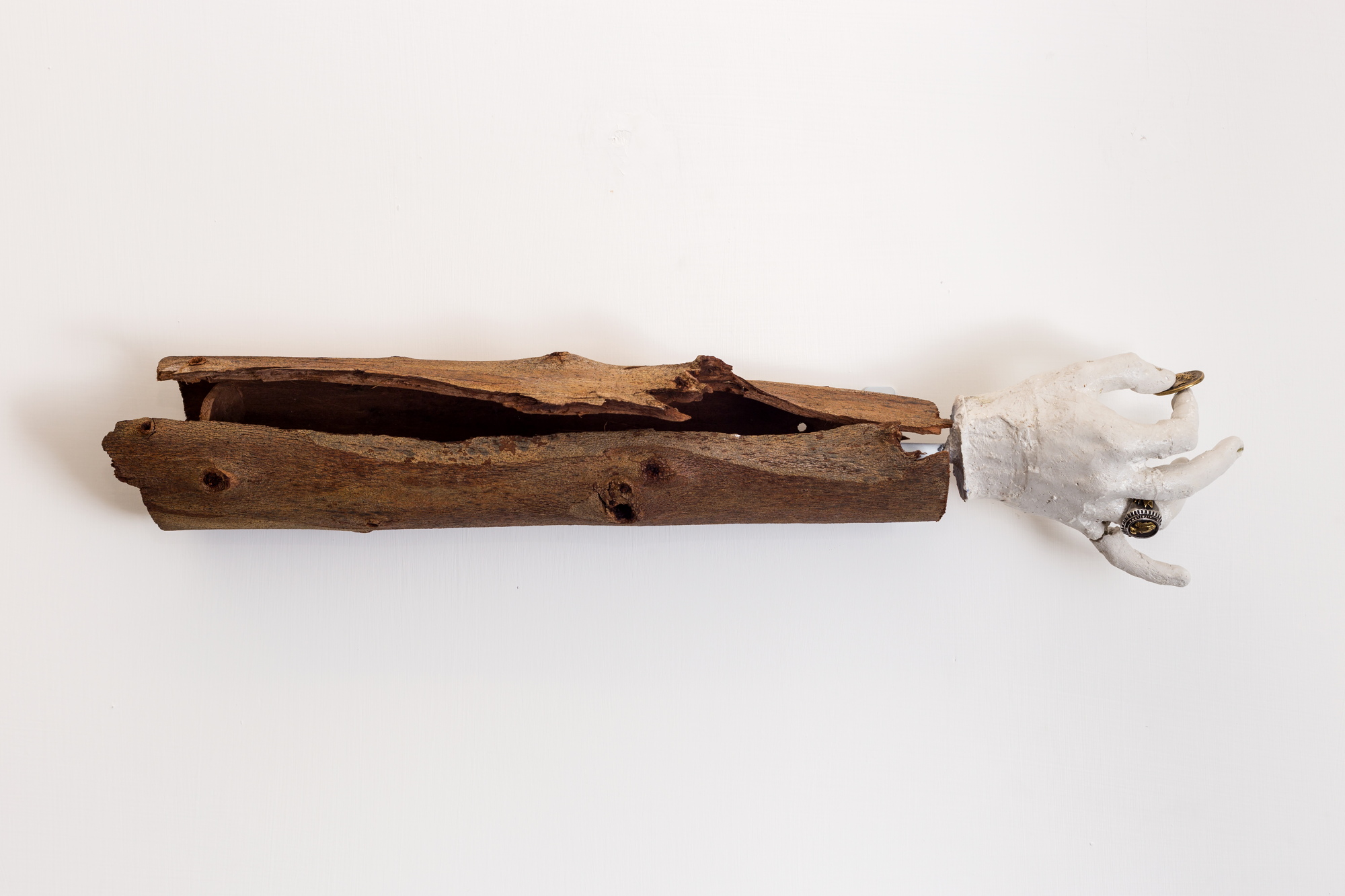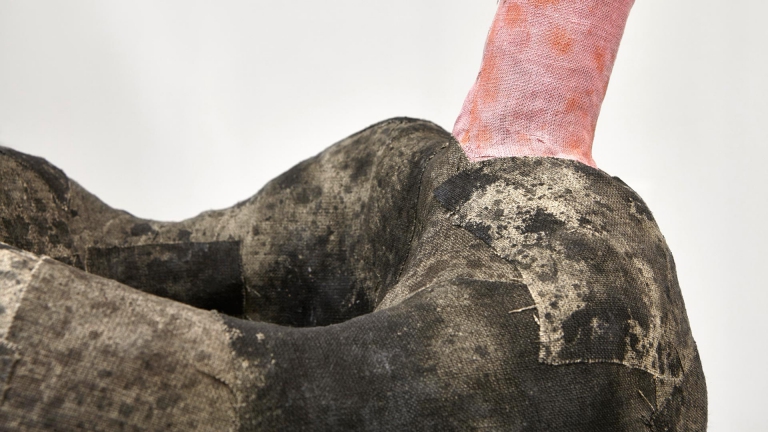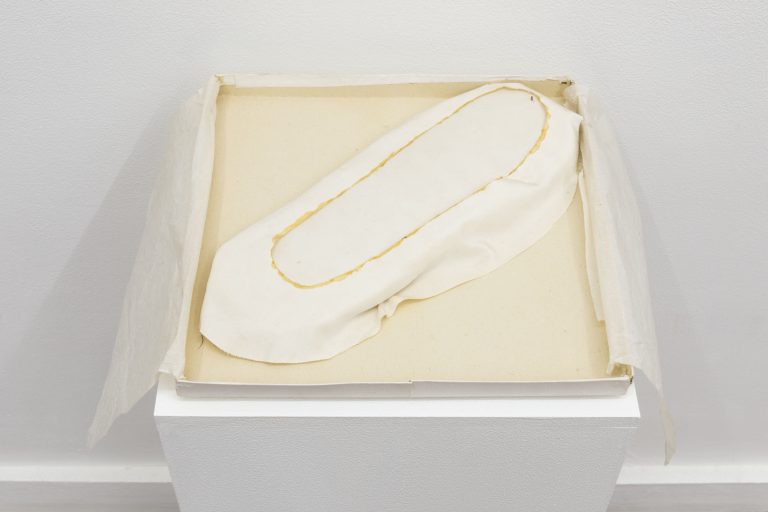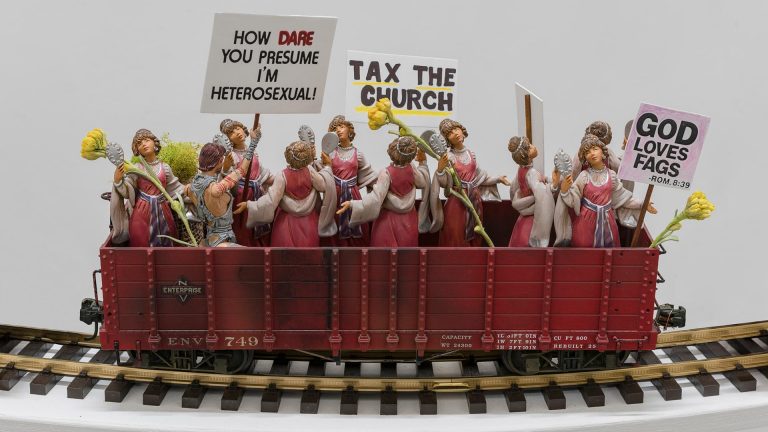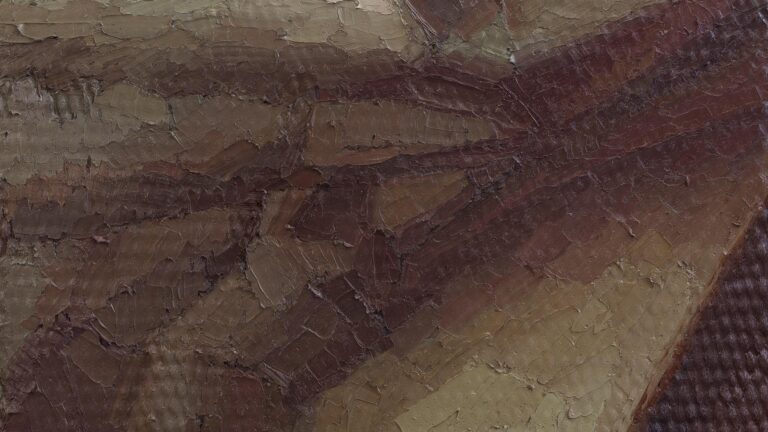Artists: Marjano & Denis Kapurani
Exhibition title: Illuminated Skeletons and Peacocks
Venue: Annarumma Galleria, Naples, Italy
Date: December 7, 2017 – February 18, 2018
Photography: all images copyright and courtesy of the artists and Annarumma Galleria, Naples
It is by no means unusual for a “new” style in the arts to exist alongside an older one which will presumably replace. What is peculiarly interesting about the history of the arts is that not one but two “new” styles could be seeking to assert themselves in the face of traditional forms. Thus, representations of scenes, from the Bible per se, or the Lives of the Saints, depend upon dramatic gestures and facial expressions, as well as upon human figures, which carry the action and make it vividly comprehensible through the immediacy of their naturalism. Moreover, forms are being transmuted into something more picturesque, including details taken from the Gospels, as to favor a compendium of amusing stories and fantastic additions from the strict Gospel narrative, as well as incidents for the simple dogmatic themes of either the New Testament or the antique world. Hence, illusions, personal feelings-even human injudicious restorations- serve as scenery to a play.
Within such milieu, Marjano and Denis Kapurani’s exhibition “Illuminated Skeletons and Peacocks” thematically works as a hinge on the doomed 18th century love affair of Lady Hamilton and Lord Nelson, as described in the book The Volcano Lover by Susan Sontag [1].
The story laid out in the book concerns the romance between the British naval hero, Horatio Nelson, and Emma Hamilton, the beautiful wife of Sir William Hamilton, the British Ambassador to Naples. The illicit affair ended in 1805 with Nelson’s death in the Battle of Trafalgar. Emma, bereft of an estate, died penniless 10 years later in France.
As depicted by Ms. Sontag, Emma is happy to play Galatea to his Pygmalion, and so making Sir Hamilton her benefactor ‘til being beguiled by an intended-to-be-a-hero Lord Nelson. A man who, as Ms. Sontag connotes “wanted to deserve praise, to figure in history books; a man who saw himself in history paintings”.
It should be of no surprise that Sontag’s excursion into the realm of historical/romance novels serves a more rigorous agenda, such as venality and hypocrisy of many of the pillars of 18th century society; the perennial status of women as an underclass; the subservience of ethics to political and religious expediency; the greed that often fuels a patron of the arts. The novel, in its brilliant portraiture, pays tribute to the epoch the Bourbon monarchs of the Kingdom of Naples took violent revenge on the revolutionaries and intellectuals who supported the insurrection, while Sontag interjects herself into the narrative of excess, vulgarity, pillaging, cheating, danger, corruption, glitz and social outcasts. Heroes and anti-heroes: those who allow their “skeletons” to come out into prominence, to be illuminated.
In this body of works, the Kapurani brothers attempt to redefine the boundaries between illusion and reality, between art and nature, blurring them as done in the spectacles on the Baroque stage, an era the Karuranis are drawn upon. None of the important details seem to be missing in their rendering to ascertain- even with interludes of mannerism, the reintroduction of a Renaissance concept. This “reformed” period concept develops the idea in a new way through the creation of a painted space which allows the viewer to imaginatively move into the pictorial plane, as additionally assisted by active fragments of form and light that arrange themselves in discontinuous patterns. The occasionally dramatic illumination yields an intense energy, while the depicted figures appear as a logical consequence of a modern approach, as expressed in the rendition of Magdalene. Her centralized composition is stable and finely defined, as if a Halston model of the 1970s. Her personification is ruled with a legible appropriation, while her characterization, in accordance with the Aristotelian rules for tragedy, with grandeur and clarity. It seems as if the Kapurani brothers challenge Horace’s dictum “ut pictura poesis”, which identifies painting with poetry, as long as romanticism is merged with slightly sinister overtones.
On the other hand, the Kapuranis’ very-Zurbarán-like softened realism, combined with the mystical, directs their impressions to an intensified, yet controlled, substance of the ideal or the idyllic, when it comes, respectively, to either portraiture or depicted elements of landscape. Narrative elements which had played a relatively minor role in other artists’ executions, here gain considerably in importance, in the mood of the story-telling, in serenity and nostalgia, in solemnity and melancholy. This way, the Kapuranis’ compositions become simpler, broader, and in attempt more allegorical. Their forms have little of the heavy plasticity- so characteristic of seventeenth century art, thus their lightness, coloristic approach, and sparkling animation announce the coming of an appropriated baroque style to a contemporary facility and creative spontaneity.
Although Zurbarán’s feeling for linear pattern and striking color harmony is inherent in Marjano and Dennis Kapurani’s works, they express a more personal sensibility. In the emotional content of their works they reveal a character which seems particularly representational. Such vocabulary is also applicable on their sculptural attempts, in which the deliberateness they create them with contributes to the sovereign sense of the dramatic or psychological connection they showcase among the elements that make them out. This kind of connection reveals the Kapuranis’ passionate- and at times dispassionate- attitude toward life, which involves neither mockery nor sympathy, but rather feelings of poise and balance which grasp and organize the three-dimensional and visual suggestions.
In Virgil’s Eclogues the not just a literary construct, inasmuch as there are striking touches of realism in the descriptions of country life, and in the names of rustic deities and their fetes, suggests a familiar setting, both in Italy and Greece, for personal love and public tragedy, which, as a consolation for both, never attains a degree of specificity which makes the descriptions fascinating at most times. The way of looking at nature, and its mythological creatures, had come to Virgil through an almost Epicurean didactic line of influence that serves, as an analogy, to explain what the eye could not see or what it imagines to see. As narrators, the Kapurani brothers make use of a similar stylistic dichotomy in their sculptures, of a similar rigorous intellectualism in their approach, because for them the “antique” is not merely an ideal, as in the case of their Pan. For them pictorial principal came to mean more than aesthetic propriety, the romantic, the sinister, the jagged, the turbulent. For them it is an amalgam of feelings for the wilderness, fertility (even that of nature) and the filtered personal. Their intuitive personal transforms the power of a created atmosphere to an appeasing immediacy of a moment in time expressed as an artistic work.
Moreover, certain superstitious observances which possess occult powers that one could observe, in whole or partially as elements, in the Kapurani’s works, such as their penis talisman, decidedly charm the heroic versus what Vergil describes in his Aeneid as epic. Particularly, when both (the heroic and epic) bear or are turned into a genre of fragmented steps for deliberate camp. In some instances, the theme suggests the elegy of the lyric, in others it creates a dialogue between the “jolly” and a bigger-than-life intention; elements enveloped in defining camp, as Susan Sontag coined it.
The peacock, as the latter part of the exhibition and its title, came to symbolize and represent in Christianity, and especially in Catholicism, renewal and immortality, a nuance between mortal and eternal life, an exalted earthly body and a glorified soul in Heaven. Such connotations can be found in paintings and mosaics as early as the 3rd century AD on the walls of the catacombs in Rome, as well as decorative motifs on churches and buildings, since the bird even appears, among other animals, in the stable in Christ’s nativity. More so, the common belief that the peacock’s flesh didn’t decay after death came to be associated with the all-seeing eye of God that watches over and, thus, nothing escapes the universal Justice. The allegorical, medieval depictions of bestiaries, in which the peacock is among, further extend its symbolism to the attribute of pride, which, through times, equivalently implies the unaffected remains of lust.
The exhibition “Illuminated Skeletons and Peacocks” works as a full allegory that evokes and contemplates on human feelings, querying what is proper, what defines ostentation and power, what is the synergy between humanitarian instincts and hypocrisy, and for that matter how they are all contorted by piety.
-Stavros Kavalaris
[1] Susan Sontag, The Volcano Lover-A Romance, Farrar, Straus & Giroux, New York, 1992



























